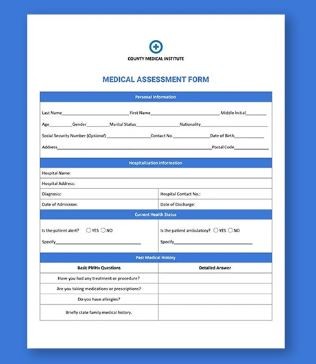In the fast-paced world of primary care, well-designed forms serve as unsung heroes that streamline workflows, enhance care quality, and empower both patients and providers. By standardizing data collection and communication, these tools address critical challenges in modern healthcare delivery. MyClinic365 now provides a way for all practices to design form templates to capture the information they need in order to:
1. Boosting Efficiency
Digital patient intake forms reduce administrative burdens by 30-50% compared to paper processes [5][11]. Practices using automated registration systems report 40% faster check-ins and fewer transcription errors [3][15]. This reclaimed time allows clinicians to focus on direct patient care rather than paperwork [1][4].
2. Improving Care Accuracy
Structured medical history forms capture 92% more relevant health details than free-form documentation [1][14]. Standardized encounter checklists from the WHO ensure systematic evaluations, reducing diagnostic oversights by 25% [2][18]. Integrated eForms automatically populate EHRs, minimizing manual entry errors that account for 15% of medication mistakes [4][7].
3. Enhancing Patient Experience
Online forms completed pre-visit reduce waiting room time by 35% while giving providers better-prepared insights into patient needs [5][11]. Customizable digital forms also improve accessibility for patients with disabilities or language barriers [3][18]. Post-care feedback forms drive 20% higher patient satisfaction through service improvements [9][16].
4. Enabling Coordinated Care
Standard referral forms between primary and specialty care reduce communication errors by 60% [17]. Shared prescription management templates across Primary Care Networks decrease duplicate testing by 40% while improving medication safety [3][7]. Centralized health records accessible via integrated forms help 78% of providers make better-informed treatment decisions [4][6].
As an example the shift toward dynamic, digital forms aligns with NHS England’s patient safety strategy, which links structured documentation to 30% fewer clinical errors [7][13]. As primary care evolves, these tools will remain vital for balancing efficiency with personalized, evidence-based medicine. By reducing administrative burdens while improving data quality, well-implemented form systems create a virtuous cycle – clinicians gain time for meaningful patient interactions, leading to better outcomes and higher job satisfaction [1][10][18].
To schedule a demo please click here. Or alternatively email info@myclinic365.com.
Citations:
[1] https://chartrequest.com/primary-care-physician-pcp-forms/
[2] https://www.who.int/teams/integrated-health-services/clinical-services-and-systems/primary-care
[3] https://www.england.nhs.uk/long-read/how-to-improve-care-related-processes-in-general-practice/
[4] https://igspectrum.com/streamlining-healthcare-the-power-of-eforms-and-ereferrals-in-modern-medicine/
[5] https://www.rectanglehealth.com/resources/blogs/digital-registration-form-benefits/
[6] https://health.ec.europa.eu/document/download/c3e2c0c3-18cd-4155-8339-4456d619e0f7_en
[7] https://www.england.nhs.uk/long-read/primary-care-patient-safety-strategy/
[8] https://simpleinteract.com/blog/digital-patient-forms/
[9] https://evidence.nihr.ac.uk/collection/improving-care-by-using-patient-feedback/
[10] https://qualitysafety.bmj.com/content/28/7/582
[11] https://www.linkedin.com/pulse/why-you-need-dynamic-forms-your-medical-practice-ravi-kalidindi-zs3rc
[12] https://bmjopen.bmj.com/content/5/12/e009993
[13] https://www.health.org.uk/sites/default/files/ImprovingSafetyInPrimaryCare.pdf
[14] https://www.researchgate.net/publication/325405066_Impact_of_electronic_forms_for_patients_on_workflow_in_primary_care
[15] https://www.ncbi.nlm.nih.gov/books/NBK2682/
[16] https://www.health.org.uk/sites/default/files/QualityImprovementMadeSimple.pdf
[17] https://pmc.ncbi.nlm.nih.gov/articles/PMC11191734/
[18] https://www.who.int/docs/default-source/primary-health-care-conference/quality.pdf
[19] https://www.ncbi.nlm.nih.gov/books/NBK571808/
[20] https://pmc.ncbi.nlm.nih.gov/articles/PMC8337146/



